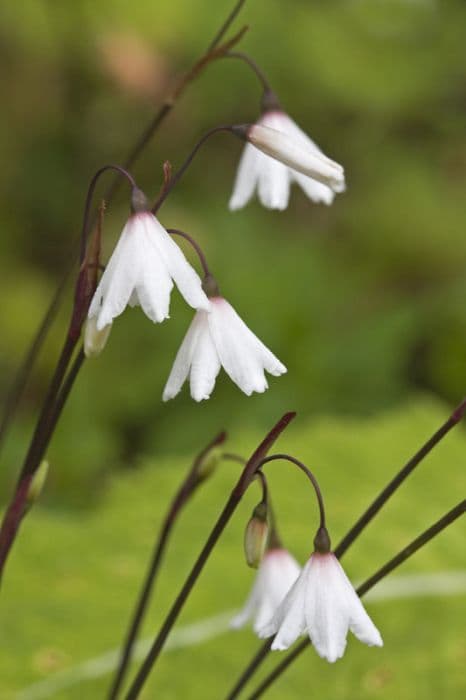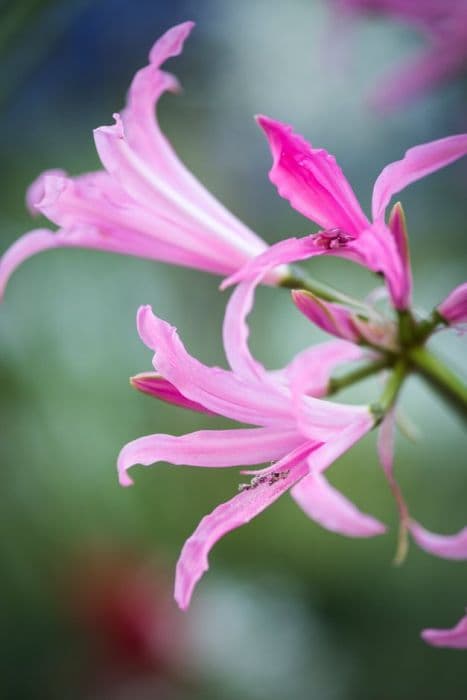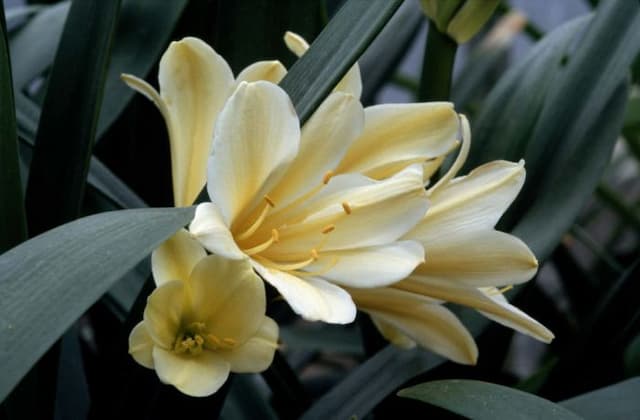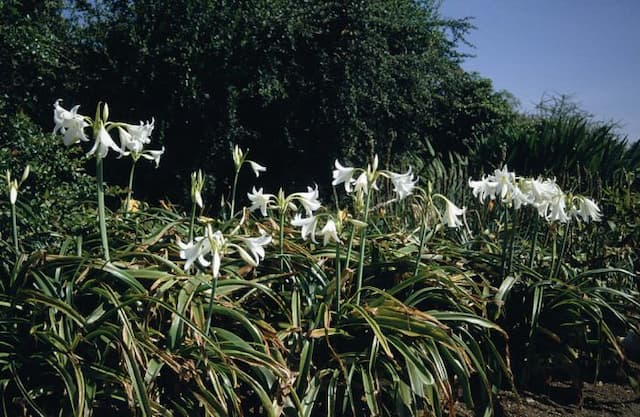Daffodil Narcissus 'Hillstar' (7)

ABOUT
The Narcissus 'Hillstar' is known for its beautiful and distinctive blooms. They appear as elegant trumpet-shaped flowers with a remarkable coloration that tends to captivate the onlooker. The petals are commonly a soft, creamy white color which can sometimes look like they are almost infused with sunlight. The trumpet, also referred to as the corona, has a contrasting lemon-yellow hue that gradually fades to white towards the edges. This exquisite combination gives the flower a star-like appearance, hence the name 'Hillstar'. The flowers are usually borne on sturdy stems which arise from a clump of strap-shaped, green leaves that are smooth and tend to arch gracefully. These leaves provide an attractive backdrop for the blooms. The 'Hillstar' often flowers in the spring and is a popular choice among gardeners for its delightful colors and ease of care. Despite each bloom's delicate appearance, the plant is relatively hardy and can withstand a range of conditions in the garden. The flowers are arranged individually on each stem, and the plant typically produces multiple stems, creating a wonderful display when several flowers are in bloom at once. The combination of the gentle white petals and the striking yellow trumpet makes the 'Hillstar' a favored selection for garden displays, cut flower arrangements, and as a harbinger of the changing seasons.
About this plant
 Names
NamesFamily
Amaryllidaceae
Synonyms
Jonquil, Daffodil
Common names
Narcissus 'Hillstar'
 Toxicity
ToxicityTo humans
Daffodil, which includes the Narcissus 'Hillstar', is toxic to humans if ingested. The plant contains alkaloids such as lycorine, which can cause symptoms like nausea, vomiting, diarrhea, and abdominal pain. In severe cases, ingestion can lead to dehydration, convulsions, and even paralysis. Handling the bulb might cause skin irritation due to calcium oxalate crystals. It is important to seek medical attention if daffodil poisoning is suspected.
To pets
Daffodil, which encompasses the Narcissus 'Hillstar', is poisonous to pets if any part of the plant is ingested. The bulb is particularly toxic and can cause symptoms such as vomiting, excessive salivation, diarrhea, abdominal pain, and sometimes more serious symptoms like cardiac arrhythmias or respiratory depression. If a pet ingests daffodil, immediate veterinary care is crucial to prevent potential serious complications or death.
 Characteristics
CharacteristicsLife cycle
Perennials
Foliage type
Deciduous
Color of leaves
Green
Flower color
Yellow
Height
1 foot 4 inches (0.4 meters)
Spread
0 feet 6 inches (0.15 meters)
Plant type
Bulb
Hardiness zones
3-9
Native area
Europe
Benefits
 General Benefits
General Benefits- Ornamental Appeal: The Narcissus 'Hillstar', commonly known as Daffodil, is appreciated for its beautiful trumpet-shaped flowers and can add aesthetic value to gardens and landscapes.
- Easy to Grow: Daffodils are known for their hardiness and ease of cultivation, making them suitable for gardeners of all skill levels.
- Pest Resistant: Daffodils are known for being resistant to many pests, which can help to minimize the need for chemical treatments in the garden.
- Perennial Growth: As a perennial plant, daffodils will return for several years once planted, offering a long-lasting display without the need to replant annually.
- Spring Bloom: Daffodils are among the first flowers to bloom in spring, providing an early splash of color after the winter months.
- Naturalizing: Daffodils can spread and naturalize in an area, creating larger and more impressive displays over time with minimal intervention.
- Symbolism and Tradition: The daffodil is often associated with rebirth and new beginnings, making it a meaningful addition to gardens and a popular choice for celebratory occasions.
 Medical Properties
Medical PropertiesThis plant is not used for medical purposes.
 Air-purifying Qualities
Air-purifying QualitiesThis plant is not specifically known for air purifying qualities.
 Other Uses
Other Uses- Photography Prop: Narcissus 'Hillstar', commonly known as daffodil, can be used in photography to add a vibrant pop of color to spring-themed photo shoots, enhancing the visual appeal of the imagery.
- Natural Dye: The petals of daffodils can be used to create a natural yellow dye for fabric, providing a chemical-free coloring option for crafters and artisans.
- Garden Pest Deterrent: Daffodil bulbs contain a substance that is toxic to voles and other garden pests, deterring them from the area where they are planted.
- Flower Arranging Classes: Daffodils, including the 'Hillstar' variety, can be used in flower arranging workshops and classes to teach techniques such as arranging bulbs in springtime displays.
- Eco-friendly Confetti: Dried daffodil petals can be used as a biodegradable alternative to traditional paper confetti in celebrations.
- Botanical Art: The striking appearance of daffodils allows them to be pressed and dried for creating botanical art pieces or herbarium collections.
- Creative Writing Prompt: The distinct phases of growth and blooming of the daffodil can serve as a metaphor or prompt in creative writing exercises, symbolizing rebirth and new beginnings.
- Mood Boards: Daffodils can be included in mood boards or vision boards for interior design and event planning, providing a burst of joy and color inspiration.
- Play Props: In school plays and amateur theatre, daffodils can be used as props to represent springtime or to create a garden setting onstage.
- Palette Inspiration: Artists may use the range of yellows in the 'Hillstar' daffodil petals as inspiration for a painting palette or color scheme in art projects.
Interesting Facts
 Feng Shui
Feng ShuiThe Daffodil is not typically used in Feng Shui practice.
 Zodiac Sign Compitability
Zodiac Sign CompitabilityThe Daffodil is not used in astrology practice.
 Plant Symbolism
Plant Symbolism- Rebirth and New Beginnings: The Narcissus, commonly known as the Daffodil, is one of the first flowers to bloom in spring, symbolizing the end of winter and the arrival of new life and fresh beginnings.
- Inspiration and Creativity: Because of its bright appearance, the Daffodil is often associated with inspiration and artistic creativity.
- Self-love: Named after Narcissus in Greek mythology, who was known for his self-obsession, the Daffodil can represent self-love and even vanity.
- Renewal: The Daffodil's life cycle represents renewal, making it a symbol for those who wish to start afresh or make positive changes.
- Inner Reflection: In some cultures, the solitary nature of the Daffodil bloom is a reminder to take time for introspection and self-discovery.
- Respect: In certain contexts, the Daffodil signifies deep respect for someone, acknowledging their unique individuality.
- Forgiveness: Offering a bouquet of Daffodils may symbolize a desire for forgiveness or to mend a strained relationship.
 Water
WaterDaffodils, including the Narcissus 'Hillstar', should be watered thoroughly at planting and during active growth. Once the plants are established, water them weekly if there is no significant rainfall, providing about 1 inch of water each time to moisten the soil deeply. Over-watering or allowing the bulbs to sit in waterlogged soil can cause rot, so ensure good drainage. When the daffodils are in bloom, they may require additional water, particularly if the weather is dry, to keep the flowers vibrant. After the blooming period and once the foliage begins to yellow, gradually reduce watering as the plant prepares for dormancy.
 Light
LightDaffodils like Narcissus 'Hillstar' thrive in full sunlight but can tolerate partial shade. The best spot for them is an area where they will receive at least 6 hours of direct sunlight each day. Planted beneath deciduous trees can be ideal as they receive sunlight before the trees leaf out fully.
 Temperature
TemperatureThe ideal growing temperature for daffodils such as Narcissus 'Hillstar' ranges from 50°F to 60°F. The bulbs can survive winter temperatures well below freezing but should be planted at a depth that corresponds to their size to protect them from extreme cold. Generally, daffodils can tolerate temperatures as low as 20°F and can withstand minor temperature fluctuations typical of spring and fall.
 Pruning
PruningPruning daffodils, like Narcissus 'Hillstar', is not necessary for the health of the plant but removing spent flower heads can improve appearance. Do not cut back the foliage until it has yellowed and died naturally, which typically occurs several weeks after blooming. Daffodils use their leaves to collect energy for next year's blooms, so it's important to allow them to die back naturally.
 Cleaning
CleaningAs needed
 Soil
SoilDaffodil 'Hillstar' thrives in well-drained soil with a slightly acidic to neutral pH between 6.0 and 7.0. A mix of loamy soil with added organic matter such as compost or well-rotted manure promotes healthy growth. During the growing season, a balance of moisture retention and good drainage is crucial to prevent bulb rot.
 Repotting
RepottingDaffodils, including 'Hillstar', typically do not need to be repotted often if grown in the ground; they can remain in the same spot for several years. If grown in containers, repot every 2-3 years or when the bulbs have multiplied and become crowded.
 Humidity & Misting
Humidity & MistingDaffodil 'Hillstar' tolerates a wide range of humidity levels and is adaptable to the humidity found in most outdoor garden environments. It does not have specific humidity requirements and will thrive in average ambient humidity.
 Suitable locations
Suitable locationsIndoor
Place 'Hillstar' Daffodil in bright, indirect light with cool temps.
Outdoor
Plant 'Hillstar' Daffodil in well-drained soil in full to partial sun.
Hardiness zone
3-9 USDA
 Life cycle
Life cycleThe life of Narcissus 'Hillstar', commonly known as Daffodil 'Hillstar', begins with the dormant bulb stage, which survives underground during unfavorable conditions. When conditions are right, typically in spring, the bulb sends up green shoots, which develop into leaves and a flower stalk. The flower blooms, revealing the characteristic star-shaped blossom that is usually a combination of creamy-white petals and a lemon-yellow cup. After flowering, the plant focuses on photosynthesis to gather energy, which is then stored in the bulb for the next growing season. The leaves yellow and wither away as the plant goes into dormancy. The cycle repeats annually, with the bulb producing offsets or seeds to propagate and ensure future generations.
 Propogation
PropogationPropogation time
Spring-Early Summer
The most popular method of propagation for Narcissus 'Hillstar', commonly known as the daffodil, is through division of its bulbs. The ideal time to propagate daffodils by bulb division is in the late summer to early fall, after the foliage has died down and the bulb has gone dormant. The process involves carefully digging up the daffodil bulbs from the ground and gently separating the small offset bulbs, known as bulbils, from the parent bulb. These bulbils are essentially clones of the mother plant and can be replanted immediately at a depth of about 6 inches (approximately 15 centimeters) with the pointed end facing upwards. It's important to choose healthy, disease-free bulbs for propagation and to plant them in well-drained soil with exposure to full or partial sunlight to ensure the best growth and flowering in the following season.









